Cranbourne line
The Cranbourne line is a commuter railway line in the city of Melbourne, Victoria, Australia.[1] Operated by Metro Trains Melbourne, it is the city's second longest metropolitan railway line at 44 kilometres (27 mi). The line runs from Flinders Street station in central Melbourne to Cranbourne station in the south-east, serving 24 stations via the City Loop, South Yarra, Caulfield, Oakleigh, and Dandenong.[2] The line operates for approximately 20 hours a day (from approximately 4:00 am to around midnight) with 24 hour service available on Friday and Saturday nights. During peak hour, headways of up to 5 to 15 minutes are operated with services every 15–20 minutes during off-peak hours.[1] Trains on the Cranbourne line run with a seven-car formation operated by High Capacity Metro Trains.[3]
| Cranbourne | ||||||||||||||||||||||||||||||||||||||||||||||||||||||||||||||||||||||||||||||||||||||||||||||||||||||||||||||||||||||||||||||||||||||||||||||||||||||||||||||||||||||||||||||||||||||||||||||||||||||||||||||||||||||||||
|---|---|---|---|---|---|---|---|---|---|---|---|---|---|---|---|---|---|---|---|---|---|---|---|---|---|---|---|---|---|---|---|---|---|---|---|---|---|---|---|---|---|---|---|---|---|---|---|---|---|---|---|---|---|---|---|---|---|---|---|---|---|---|---|---|---|---|---|---|---|---|---|---|---|---|---|---|---|---|---|---|---|---|---|---|---|---|---|---|---|---|---|---|---|---|---|---|---|---|---|---|---|---|---|---|---|---|---|---|---|---|---|---|---|---|---|---|---|---|---|---|---|---|---|---|---|---|---|---|---|---|---|---|---|---|---|---|---|---|---|---|---|---|---|---|---|---|---|---|---|---|---|---|---|---|---|---|---|---|---|---|---|---|---|---|---|---|---|---|---|---|---|---|---|---|---|---|---|---|---|---|---|---|---|---|---|---|---|---|---|---|---|---|---|---|---|---|---|---|---|---|---|---|---|---|---|---|---|---|---|---|---|---|---|---|---|---|---|---|
 | ||||||||||||||||||||||||||||||||||||||||||||||||||||||||||||||||||||||||||||||||||||||||||||||||||||||||||||||||||||||||||||||||||||||||||||||||||||||||||||||||||||||||||||||||||||||||||||||||||||||||||||||||||||||||||
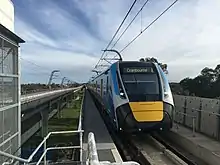 A Cranbourne line High Capacity Metro Train arriving at Hughesdale station. | ||||||||||||||||||||||||||||||||||||||||||||||||||||||||||||||||||||||||||||||||||||||||||||||||||||||||||||||||||||||||||||||||||||||||||||||||||||||||||||||||||||||||||||||||||||||||||||||||||||||||||||||||||||||||||
| Overview | ||||||||||||||||||||||||||||||||||||||||||||||||||||||||||||||||||||||||||||||||||||||||||||||||||||||||||||||||||||||||||||||||||||||||||||||||||||||||||||||||||||||||||||||||||||||||||||||||||||||||||||||||||||||||||
| Service type | Commuter rail | |||||||||||||||||||||||||||||||||||||||||||||||||||||||||||||||||||||||||||||||||||||||||||||||||||||||||||||||||||||||||||||||||||||||||||||||||||||||||||||||||||||||||||||||||||||||||||||||||||||||||||||||||||||||||
| System | Melbourne railway network | |||||||||||||||||||||||||||||||||||||||||||||||||||||||||||||||||||||||||||||||||||||||||||||||||||||||||||||||||||||||||||||||||||||||||||||||||||||||||||||||||||||||||||||||||||||||||||||||||||||||||||||||||||||||||
| Status | Operational | |||||||||||||||||||||||||||||||||||||||||||||||||||||||||||||||||||||||||||||||||||||||||||||||||||||||||||||||||||||||||||||||||||||||||||||||||||||||||||||||||||||||||||||||||||||||||||||||||||||||||||||||||||||||||
| Locale | Melbourne, Victoria, Australia | |||||||||||||||||||||||||||||||||||||||||||||||||||||||||||||||||||||||||||||||||||||||||||||||||||||||||||||||||||||||||||||||||||||||||||||||||||||||||||||||||||||||||||||||||||||||||||||||||||||||||||||||||||||||||
| Predecessor |
| |||||||||||||||||||||||||||||||||||||||||||||||||||||||||||||||||||||||||||||||||||||||||||||||||||||||||||||||||||||||||||||||||||||||||||||||||||||||||||||||||||||||||||||||||||||||||||||||||||||||||||||||||||||||||
| First service | 1 October 1888 as South Gippsland line | |||||||||||||||||||||||||||||||||||||||||||||||||||||||||||||||||||||||||||||||||||||||||||||||||||||||||||||||||||||||||||||||||||||||||||||||||||||||||||||||||||||||||||||||||||||||||||||||||||||||||||||||||||||||||
| Current operator(s) | Metro Trains | |||||||||||||||||||||||||||||||||||||||||||||||||||||||||||||||||||||||||||||||||||||||||||||||||||||||||||||||||||||||||||||||||||||||||||||||||||||||||||||||||||||||||||||||||||||||||||||||||||||||||||||||||||||||||
| Former operator(s) |
| |||||||||||||||||||||||||||||||||||||||||||||||||||||||||||||||||||||||||||||||||||||||||||||||||||||||||||||||||||||||||||||||||||||||||||||||||||||||||||||||||||||||||||||||||||||||||||||||||||||||||||||||||||||||||
| Route | ||||||||||||||||||||||||||||||||||||||||||||||||||||||||||||||||||||||||||||||||||||||||||||||||||||||||||||||||||||||||||||||||||||||||||||||||||||||||||||||||||||||||||||||||||||||||||||||||||||||||||||||||||||||||||
| Termini | Flinders Street Cranbourne | |||||||||||||||||||||||||||||||||||||||||||||||||||||||||||||||||||||||||||||||||||||||||||||||||||||||||||||||||||||||||||||||||||||||||||||||||||||||||||||||||||||||||||||||||||||||||||||||||||||||||||||||||||||||||
| Stops | 24 (including City Loop stations) | |||||||||||||||||||||||||||||||||||||||||||||||||||||||||||||||||||||||||||||||||||||||||||||||||||||||||||||||||||||||||||||||||||||||||||||||||||||||||||||||||||||||||||||||||||||||||||||||||||||||||||||||||||||||||
| Distance travelled | 43.920 km (27.291 mi) | |||||||||||||||||||||||||||||||||||||||||||||||||||||||||||||||||||||||||||||||||||||||||||||||||||||||||||||||||||||||||||||||||||||||||||||||||||||||||||||||||||||||||||||||||||||||||||||||||||||||||||||||||||||||||
| Average journey time | 59 minutes (not via City Loop) | |||||||||||||||||||||||||||||||||||||||||||||||||||||||||||||||||||||||||||||||||||||||||||||||||||||||||||||||||||||||||||||||||||||||||||||||||||||||||||||||||||||||||||||||||||||||||||||||||||||||||||||||||||||||||
| Service frequency |
| |||||||||||||||||||||||||||||||||||||||||||||||||||||||||||||||||||||||||||||||||||||||||||||||||||||||||||||||||||||||||||||||||||||||||||||||||||||||||||||||||||||||||||||||||||||||||||||||||||||||||||||||||||||||||
| Line(s) used | ||||||||||||||||||||||||||||||||||||||||||||||||||||||||||||||||||||||||||||||||||||||||||||||||||||||||||||||||||||||||||||||||||||||||||||||||||||||||||||||||||||||||||||||||||||||||||||||||||||||||||||||||||||||||||
| Technical | ||||||||||||||||||||||||||||||||||||||||||||||||||||||||||||||||||||||||||||||||||||||||||||||||||||||||||||||||||||||||||||||||||||||||||||||||||||||||||||||||||||||||||||||||||||||||||||||||||||||||||||||||||||||||||
| Rolling stock | HCMT | |||||||||||||||||||||||||||||||||||||||||||||||||||||||||||||||||||||||||||||||||||||||||||||||||||||||||||||||||||||||||||||||||||||||||||||||||||||||||||||||||||||||||||||||||||||||||||||||||||||||||||||||||||||||||
| Track gauge | 1,600 mm (5 ft 3 in) | |||||||||||||||||||||||||||||||||||||||||||||||||||||||||||||||||||||||||||||||||||||||||||||||||||||||||||||||||||||||||||||||||||||||||||||||||||||||||||||||||||||||||||||||||||||||||||||||||||||||||||||||||||||||||
| Electrification | 1500 V DC overhead | |||||||||||||||||||||||||||||||||||||||||||||||||||||||||||||||||||||||||||||||||||||||||||||||||||||||||||||||||||||||||||||||||||||||||||||||||||||||||||||||||||||||||||||||||||||||||||||||||||||||||||||||||||||||||
| Track owner(s) | VicTrack | |||||||||||||||||||||||||||||||||||||||||||||||||||||||||||||||||||||||||||||||||||||||||||||||||||||||||||||||||||||||||||||||||||||||||||||||||||||||||||||||||||||||||||||||||||||||||||||||||||||||||||||||||||||||||
| ||||||||||||||||||||||||||||||||||||||||||||||||||||||||||||||||||||||||||||||||||||||||||||||||||||||||||||||||||||||||||||||||||||||||||||||||||||||||||||||||||||||||||||||||||||||||||||||||||||||||||||||||||||||||||
The line originally opened in 1888 branching off from the Gippsland line at Dandenong as the South Gippsland line.[4] Services operated as far as Port Albert, with extensive branch lines featuring on the non-electrified network. The line(s) were built to serve the regional townships of Cranbourne, Koo Wee Rup, and Leongatha, amongst others. The line was closed in 1993 after a decline in usage, however, the line was reopened and electrified to Cranbourne in 1995 as part of the "Building Better Cities" program.[5][6] Significant growth has occurred since its reopening, with proposals to extend the line two stations to Clyde receiving support amongst other works on the corridor.[7]
Since the 2010s, due to the heavily utilised infrastructure of the Cranbourne line, significant improvements and upgrades have been made. A $1 billion upgrade of the corridor between Dandenong and Cranbourne is currently under construction, with improvements including the removal of all level crossings, rebuilding stations, and the duplication of 8 km (5 mi) of track.[8] Other works taking place have included the replacement of sleepers, the introduction of new signalling technology, the introduction of new rolling stock, and other works associated with the Metro Tunnel project.[9] These projects have improved the quality and safety of the line, and will be completed by the opening of the Metro Tunnel in 2025.[10]
History
19th century
In 1888, the Cranbourne line (then known as the South Gippsland railway line) began operations, splitting off from the main line to Gippsland at Dandenong with an extension to Cranbourne.[11] The line was progressively extended to Koo Wee Rup, Nyora, and Loch in 1890, Korumburra and Leongatha in 1891, and Welshpool, Alberton, and Port Albert in 1892.[12][4] From its opening until 2022, the Cranbourne line was fully single tracked from Dandenong to its terminus, and was only electrified upon its reopening in the 1990s.[13]
Regional services

Throughout the early to mid 20th century, the South Gippsland railway line continued to open additional branch lines, including to Woodside, Barry Beach, Welshpool Jetty, Outtrim, Wonthaggi, and Strzelecki.[14] All of these branch lines ceased their operations between the mid and late 20th century due to a decrease in patronage.[14] On 6 June 1981, passenger services ceased operation to Yarram. In 1984, the line re-opened with services to Leongatha, until its second closure on 24 June 1993.[4] The Barry Beach freight service ceased operations in 1992, with the line beyond Leongatha booked out of service on 30 June 1992, thus, effectively ending all traffic on the line beyond Leongatha.[15] V/Line passenger services continued to Cranbourne till its electirifcation, with freight operations continuing into the late 1990s with freight services to the Koala siding.[15]
Metropolitan services
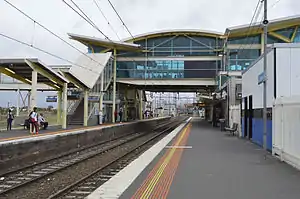
In 1995, the Australian Government launched the "Building Better Cities" program, designed to redevelop Australian cities with better communities and infrastructure.[6] The $27 million project included a rebuilt Dandenong station, a new station in Cranbourne North (Merinda Park station), the introduction of three position signalling, and electrification of the signal tracked corridor.[16] These works resulted in the re-opening of a section of the South Gippsland line to passengers which became known as the Cranbourne Line.[6]
Freight services continued on part of the South Gippsland line till 1998, when services from the Koala Siding were suspended.[17] With these changes, the line became unused beyond Cranbourne.[17] The exception was a tourist railway operation, which commenced operation between Nyora and Leongatha, and later became known as the South Gippsland Railway till its closure in January 2016.[18]
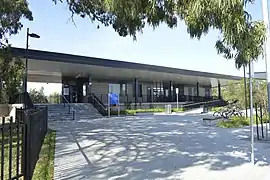
21st century
In 2008, a package of works were unveiled to upgrade the Cranbourne line to improve frequencies and the quality of service. A new siding was constructed at Cranbourne, with a capacity of 6 trains, in order to increase frequencies without having to duplicate the line.[19] In addition to the new siding, the $37 million project also brought a major upgrade to Cranbourne station, which included the construction of an enclosed waiting room, new platform shelters, new toilet facilities, formalised paved pedestrian access, an upgraded bus interchange, and increased security.[20]
In 2012, Lynbrook station opened after two years of construction works. The station serves the suburbs of Lynbrook and Lyndhurst, with the station featuring accessible platforms, car parking facilities, and bus stops.[21] In 2014, the level crossing at Springvale Road, Springvale, was removed by lowering the railway into a trench. Prior to this, the level crossing was considered the most dangerous in Victoria.[22] The removal consisted of a 1.6 km (0.99 mi) trench and the construction of a new premium station at Springvale.[23]
In September 2019, Qube Holdings commenced operating a daily service on a short section of the line, hauling containerised cement to the Kimberly-Clark siding at Dandenong South.[24]
Future
Metro Tunnel
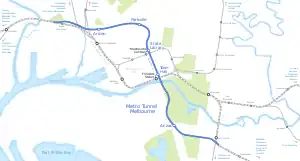
The 2012 Network Development Plan identified the need for a north–south tunnel connecting the Cranbourne and Pakenham lines to the Sunbury line.[9] In 2017, the Metro Tunnel began construction, involving the construction of five new underground stations, twin 9-kilometre (5.6 mi) tunnels, and other associated infrastructure improvements. Leaving the existing Cranbourne line alignment before South Yarra station, new stations will be built at Anzac, Town Hall (with connections to Flinders Street station), State Library (with connections to Melbourne Central), Parkville, and Arden, before continuing onto the Sunbury line. These works will be completed by 2025, and upon completion, will create a singular rail line from Cranbourne and Pakenham to Sunbury and Melbourne Airport (from 2029).[10]
Melbourne Airport Rail Link
The Melbourne Airport rail link will involve the construction of a 27-kilometre (17 mi) line from Sunshine to a new station at Melbourne Airport.[25] Connected via the Metro Tunnel, services will operate from the Cranbourne and Pakenham lines[26] through the tunnel before splitting off at Sunshine to either Sunbury or Melbourne Airport. Construction of the line will involve the renovation of Sunshine station to allow for additional platforms, construction of new track, and the addition of two new stations at Keilor East and Melbourne Airport.[27] Construction started in 2022 with services expected to begin in 2029.[28]
Clyde Extension
Services on the South Gippsland line were fully suspended in 1981 due to limited passenger numbers on the route. Since the closure, calls have been made to reopen the line to the suburb of Clyde. Reopening of the line to Clyde was first promised by the Australian Labor Party during the 1999 and 2002 state election campaigns, but were dumped before the 2006 election.[29] In November 2003, a "Trainlink" bus service was introduced as an alternative, meeting each train at Cranbourne station and running on a largely one-way loop through Cranbourne East.[30] The Bracks governments Victorian Transport Plan, released in 2008, listed the extensions and associated works as a "medium term" project, which was estimated to cost $200 million.[31] Despite the political promise to revive the railway line for freight and passenger services by the Bracks-led Labor government in 1999, the project was abandoned in 2008 by his successor John Brumby.[32]
In 2013, as part of Public Transport Victoria's Network Development Plan for metropolitan rail, an extension of the Cranbourne line to Clyde was earmarked to begin in the "long-term", which would equate to at least over the next 20 years.[33] In January 2018, City of Casey advised it would need almost $3 billion worth of rail and road infrastructure projects to continue development of the region, including the extension of the metropolitan train from Cranbourne to Clyde and the duplication of the line between Dandenong and Cranbourne. In the lead up to the 2018 state election, the incumbent Andrews government announced the Cranbourne Line Upgrade, a project involving the duplication of 8 km of track between Dandenong and Cranbourne, a rebuilt Merinda Park station, the construction of a new rail connection for the Port Rail Shuttle Network, and the removal of all remaining level crossings on the corridor.[34] Andrews argued that this project was required if an extension to Clyde was to be constructed.[34] Opposition leader Matthew Guy instead promised that he would extend the Cranbourne line to Clyde if he won the election.[35]
Again in the lead up to the 2022 state election, the City of Casey increased its campaign for the extension of the rail line to Clyde, including the construction of 3 new stations.[7] The City of Casey proposal involved the construction of stations at Cranbourne East, Casey Fields (only proposed by the council), and Clyde.[7] This proposal was supported again by opposition leader Matthew Guy, minus the station at Casey Fields.[36] The incumbent Andrews government made no commitments to the Clyde rail extension, instead continuing construction on the Cranbourne Line Upgrade.[37] The 2022 state election resulted in another Labor victory, with the Andrews government pushing ahead with the Cranbourne Line Upgrade, with the extension to Clyde remaining stagnant ever since.[38]
Level Crossing Removals
The Level Crossing Removal Project has announced the removal of all 15 remaining level crossings on the Cranbourne line, to be completed in stages from 2018 to 2025. All level crossings between Caulfield and Dandenong were removed in 2018 as part of the Caulfield to Dandenong skyrail project.[39] This included the removal of nine level crossings and the reconstruction of five elevated stations along the corridor.[40] The second phase of removals involves removing individual crossings along the corridor through a variety of methods by 2025.[41] Some crossings have been removed through elevating the rail corridor, some by lowering or raising the road, with other crossings being removed by closing the crossing off from motor traffic.[42] These projects will leave the entirety of the Cranbourne line level crossing free by 2025, with projects on the Sunbury line leaving the entire Sunshine-Dandenong corridor crossing free by the opening of the Metro Tunnel in 2025.[43]
Cranbourne Line Upgrade
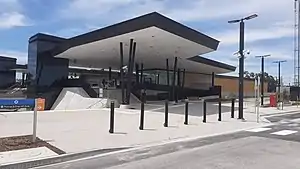
Announced in the lead up to the 2018 Victorian state election, the Cranbourne line would receive a $1 billion upgrade to coincide with the opening of the Metro Tunnel.[44] The project is being delivered by the Level Crossing Removal Project, and will include:[8]
- The removal of the four remaining level crossings (50% complete)
- Evans Road, Lyndhurst (complete)
- Greens Road, Dandenong South (complete)
- Camms Road, Cranbourne (gone by 2024)
- Webster Street, Dandenong (gone by 2025)
- The duplication of 8 kilometres (5 mi) of single track between Dandenong South and Cranbourne (complete)
- The installation of a second rail bridge at Abbotts Road and Eumemmerring Creek in Dandenong South (complete)
- The reconstruction of Merinda Park station (complete)
- The delivery of a new rail connection for the Port Rail Shuttle Network (underway)
In 2020, the level crossing at Evans Road in Lyndhurst was removed through the construction of a road bridge over the rail line. In early 2021, the first platform of the newly rebuilt Merinda Park station was opened, with the second platform opening a year later.[45] In February 2022, the second platform at Merinda Park was opened along with the completion of duplication works.[13] After the duplication works, the line could now handle 10-minute frequencies during peak periods. As a result, the timetable was rewritten to allow for 50 extra Cranbourne services to operate every week.[46] Alongside the duplication works, all level crossings on the line will be removed. The Cranbourne line is projected to become the first crossing-free line on the network, with the remaining two crossings and other upgrade works expected to be completed by 2025.[47]
Network and Operations
Services
Services on the Cranbourne line operates from approximately 4:00 am to around 11:30 pm daily.[48] In general, during peak hours, train frequency is 5 minutes on the Dandenong corridor (combined with the Pakenham line) and 10 minutes in the AM peak on the Cranbourne line while during non-peak hours the frequency is reduced to 20–30 minutes throughout the entire route.[49] Cranbourne line services operate as shuttles to and from Dandenong between 10:00 pm and 6:00 am, connecting with Pakenham line trains. During the peak, some services originate and terminate at Westall or Dandenong. Services run anticlockwise through the City Loop, and from 2025, Cranbourne line services will cease to stop at South Yarra, Richmond, and all City Loop stations when trains are rerouted through the Metro Tunnel upon opening.[49][50] On Friday nights and weekends, services run 24 hours a day, with 60 minute frequencies available outside of normal operating hours.[51] Since 13 February 2022, some off-peak daytime Cranbourne line services (and Pakenham line services) stop at Malvern station, running express between South Yarra and Malvern stations.[52]
Freight operations are limited, with Qube Holdings operating a daily service on a short section of the line hauling containerised cement to the Kimberly-Clark siding at Dandenong South.[24]
Train services on the Cranbourne line are also subjected to maintenance and renewal works, usually on selected Fridays and Saturdays. Shuttle bus services are provided throughout the duration of works for affected commuters.[53]
Stopping Patterns
Legend — Station Status
- ◼ Premium Station – Station staffed from first to last train
- ◻ Host Station – Usually staffed during morning peak, however this can vary for different stations on the network.
Legend — Stopping Patterns
Some services do not operate via the City Loop
- ● – All trains stop
- ◐ – Some services do not stop
- ▲ – Only inbound trains stop (trains operate counter-clockwise through the City Loop all day)
- | – Trains pass and do not stop
| Cranbourne Services[54] | ||||
|---|---|---|---|---|
| Station | Zone | Local | Ltd Express | Shuttle |
| ◼ Flinders Street | 1 | ● | ● | |
| ◼ Southern Cross | ▲ | ▲ | ||
| ◼ Flagstaff | ▲ | ▲ | ||
| ◼ Melbourne Central | ▲ | ▲ | ||
| ◼ Parliament | ▲ | ▲ | ||
| ◼ Richmond | ● | ● | ||
| ◼ South Yarra | ● | ● | ||
| ◻ Malvern | ◐ | | | ||
| ◼ Caulfield | ● | ● | ||
| ◼ Carnegie | ● | | | ||
| ◼ Murrumbeena | ● | | | ||
| ◻ Hughesdale | 1/2 | ● | | | |
| ◼ Oakleigh | ● | ● | ||
| ◻ Huntingdale | ● | | | ||
| ◼ Clayton | 2 | ● | ● | |
| ◼ Westall | ● | ● | ||
| ◼ Springvale | ● | ● | ||
| Sandown Park | ● | ● | ||
| ◼ Noble Park | ● | ● | ||
| Yarraman | ● | ● | ||
| ◼ Dandenong | ● | ● | ● | |
| Lynbrook | ● | ● | ● | |
| Merinda Park | ● | ● | ● | |
| ◼ Cranbourne | ● | ● | ● | |
Operators
The Cranbourne line has had a total of 5 operators since its reopening in 1995. The majority of operations throughout its history have been privately run.
The government-owned Public Transport Corporation and later Bayside Trains operated the line for a short 4 years till the 1999 privatisation of Melbourne's rail network.[55]
Bayside Trains was privatised in August 1999 and later rebranded M>Train. In 2002, M>Train was placed into receivership and the state government regained ownership of the line, with KPMG appointed as receivers to operate M>Train on behalf of the state government.[56][57][58] Two years later, rival train operator Connex Melbourne took over the M>Train operations including the Cranbourne line. Metro Trains Melbourne, the current private operator, then took over the operations in 2009. The private operators have had a combined operational period of 24 years.[59]
| Operator | Assumed operations | Ceased operations | Length of operations |
|---|---|---|---|
| Public Transport Corporation | 1995 | 1998 | 3 years |
| Bayside Trains (government operator) | 1998 | 1999 | 1 years |
| M>Train | 1999 | 2004 | 5 years |
| Connex Melbourne | 2004 | 2009 | 5 years |
| Metro Trains Melbourne | 2009 | incumbent | 13 years (ongoing) |
Route
Cranbourne railway line | ||||||||||||||||||||||||||||||||||||||||||||||||||||||||||||||||||||||||||||||||||||||||||||||||||||||||||||||||||||||||||||||||||||||||||||||||||||||||||||||||||||||||||||||||||||||||||||||||||||||||||||||||||||||||||||||||||||||||||||||||||||||||||||||||||||||||||||||||||||||||||||||||||||||||||||||||||||||||||||||||||||||||||||||||||||||||||||||||||||||||||||||||||||||||||||||||||||||||||||||||||||||||||||||||||||||||||||||||||||||||||||||||||||||||||||||||||||||||||||||||||||||||||||||||||||||||||||||||||||||||||||||||||||||||||||||||||||||||||||||||||||||||||||||||||||||||||||
|---|---|---|---|---|---|---|---|---|---|---|---|---|---|---|---|---|---|---|---|---|---|---|---|---|---|---|---|---|---|---|---|---|---|---|---|---|---|---|---|---|---|---|---|---|---|---|---|---|---|---|---|---|---|---|---|---|---|---|---|---|---|---|---|---|---|---|---|---|---|---|---|---|---|---|---|---|---|---|---|---|---|---|---|---|---|---|---|---|---|---|---|---|---|---|---|---|---|---|---|---|---|---|---|---|---|---|---|---|---|---|---|---|---|---|---|---|---|---|---|---|---|---|---|---|---|---|---|---|---|---|---|---|---|---|---|---|---|---|---|---|---|---|---|---|---|---|---|---|---|---|---|---|---|---|---|---|---|---|---|---|---|---|---|---|---|---|---|---|---|---|---|---|---|---|---|---|---|---|---|---|---|---|---|---|---|---|---|---|---|---|---|---|---|---|---|---|---|---|---|---|---|---|---|---|---|---|---|---|---|---|---|---|---|---|---|---|---|---|---|---|---|---|---|---|---|---|---|---|---|---|---|---|---|---|---|---|---|---|---|---|---|---|---|---|---|---|---|---|---|---|---|---|---|---|---|---|---|---|---|---|---|---|---|---|---|---|---|---|---|---|---|---|---|---|---|---|---|---|---|---|---|---|---|---|---|---|---|---|---|---|---|---|---|---|---|---|---|---|---|---|---|---|---|---|---|---|---|---|---|---|---|---|---|---|---|---|---|---|---|---|---|---|---|---|---|---|---|---|---|---|---|---|---|---|---|---|---|---|---|---|---|---|---|---|---|---|---|---|---|---|---|---|---|---|---|---|---|---|---|---|---|---|---|---|---|---|---|---|---|---|---|---|---|---|---|---|---|---|---|---|---|---|---|---|---|---|---|---|---|---|---|---|---|---|---|---|---|---|---|---|---|---|---|---|---|---|---|---|---|---|---|---|---|---|---|---|---|---|---|---|---|---|---|---|---|---|---|---|---|---|---|---|---|---|---|---|---|---|---|---|---|---|---|---|---|---|---|---|---|---|---|---|---|---|---|---|---|---|---|---|---|---|---|---|---|---|---|---|---|---|---|---|---|---|---|---|---|---|---|---|---|---|---|---|---|---|---|---|---|---|---|---|---|---|---|---|---|---|---|---|---|---|---|---|---|---|---|---|---|---|---|---|---|---|---|---|---|---|---|---|---|---|---|---|---|---|---|---|---|---|---|---|---|---|---|---|---|---|---|---|---|---|---|---|---|---|---|---|---|---|---|---|---|---|---|---|---|---|---|---|---|---|---|---|---|---|---|---|---|---|---|---|---|---|---|---|---|---|---|---|---|---|---|---|---|---|---|---|
| ||||||||||||||||||||||||||||||||||||||||||||||||||||||||||||||||||||||||||||||||||||||||||||||||||||||||||||||||||||||||||||||||||||||||||||||||||||||||||||||||||||||||||||||||||||||||||||||||||||||||||||||||||||||||||||||||||||||||||||||||||||||||||||||||||||||||||||||||||||||||||||||||||||||||||||||||||||||||||||||||||||||||||||||||||||||||||||||||||||||||||||||||||||||||||||||||||||||||||||||||||||||||||||||||||||||||||||||||||||||||||||||||||||||||||||||||||||||||||||||||||||||||||||||||||||||||||||||||||||||||||||||||||||||||||||||||||||||||||||||||||||||||||||||||||||||||||||
The Cranbourne line forms a relatively linear route from the Melbourne CBD to its terminus in Cranbourne. The line is 44 kilometres (27 mi) long and predominantly double-tracked; however, between Flinders Street station and Richmond, the track is widened to 12 tracks, narrowing to 6 tracks between Richmond and South Yarra before again narrowing to 4 tracks between South Yarra and Caulfield.[60] After Caulfield station, the track again narrows to two tracks, which remain for the rest of the route. The only underground section of the Cranbourne line is in the City Loop, where the service stops at 3 underground stations and operates in a counter-clockwise direction.[61] Exiting the city, the Cranbourne line traverses mainly flat country with few curves and fairly minimal earthworks for most of the line. However, between South Yarra and Malvern, the rail corridor has been lowered into a cutting to eliminate level crossings, and between Malvern and Caulfield, the corridor it has been raised on an embankment for the same reason.[62] After Caulfield, the line formerly had numerous level crossings; all have now been abolished between Caulfield and Dandenong as part of an elevated rail project, as well as some older bridges over and under roads.[63] The remaining crossing will be fully removed by 2025, with the Cranbourne line becoming the first fully level crossing free line on the Melbourne railway network.
The line follows the same alignment as the Pakenham line along the Gippsland line, with the two services splitting onto different routes at Dandenong. The Cranbourne line turns south and branches on to the South Gippsland line, while the Pakenham line continues along the Gippsland line.[64] Most of the rail line goes through built-up suburbs and some industrial areas, but after Dandenong, the line gets into a mix of both open fields and suburbia.[64] This outer portion of the line is one of Melbourne's main growth corridors, which is rapidly replacing farmland with housing and commercial developments, adding additional passengers to the line each year.[65]
Stations
The line serves 24 stations across 44 kilometres (27 mi) of track. The stations are a mix of elevated, lowered, underground, and ground level designs. Underground stations are present only in the City Loop, with the majority of elevated and lowered stations being constructed as part of level crossing removals.[66][67] From 2025, services will cease to stop at Flinders Street, Southern Cross, Flagstaff, Melbourne Central, Parliament, Richmond, and South Yarra stations due to the opening of the Metro Tunnel.
| Station | Opened[68] | Closed[68] | Age | Notes[68][10] |
|---|---|---|---|---|
| Flinders Street | 12 September 1854 || || data-sort-value=61,769 | 169 years |
| ||
| Southern Cross | 17 January 1859 || || data-sort-value=60,181 | 164 years |
| ||
| Flagstaff | 27 May 1985 || || data-sort-value=14,030 | 38 years |
| ||
| Melbourne Central | 26 January 1981 || || data-sort-value=15,612 | 42 years |
| ||
| Parliament | 22 January 1983 || || data-sort-value=14,886 | 40 years |
| ||
| Princes Bridge | 8 February 1859 || 1 October 1866 || data-sort-value=2,792 | 7 years | |||
| 2 April 1879 || 30 June 1980 || data-sort-value=36,979 | 101 years | ||||
| Botanic Gardens | 2 March 1859 || c. April 1862 || data-sort-value=1,150 | Approx. 3 years | |||
| Punt Road | 8 February 1859 || 12 December 1859 || data-sort-value=307 | 10 months |
| ||
| Richmond | 12 December 1859 || || data-sort-value=59,852 | 163 years |
| ||
| Cremorne | 12 December 1859 || c. 28 December 1863 || data-sort-value=1,477 | Approx. 4 years | |||
| South Yarra | 22 December 1860 || || data-sort-value=59,476 | 162 years |
| ||
| Hawksburn | 7 May 1889 || || data-sort-value=49,113 | 134 years |
| ||
| Toorak | 7 May 1879 || || data-sort-value=52,766 | 144 years |
| ||
| Armadale | 7 May 1879 || || data-sort-value=52,766 | 144 years |
| ||
| Malvern | 7 May 1879 || || data-sort-value=52,766 | 144 years | |||
| Caulfield | 7 May 1879 || || data-sort-value=52,766 | 144 years | |||
| Carnegie | 14 May 1879 || || data-sort-value=52,759 | 144 years |
| ||
| Murrumbeena | 14 May 1879 || || data-sort-value=52,759 | 144 years | |||
| Hughesdale | 28 February 1925 || || data-sort-value=36,033 | 98 years | |||
| Oakleigh | 8 October 1877 || || data-sort-value=53,342 | 146 years | |||
| Huntingdale | 25 June 1927 || || data-sort-value=35,186 | 96 years |
| ||
| Clayton | 6 January 1880 || || data-sort-value=52,522 | 143 years |
| ||
| Westall | 6 February 1951 || || data-sort-value=26,559 | 72 years | |||
| APEX Siding (Westall) | ? | - |
| |
| Springvale | 1 September 1880 || || data-sort-value=52,283 | 143 years |
| ||
| Sandown Park | c. December 1888 || 15 May 1955 || data-sort-value=24,246 | Approx. 66 years |
| ||
| 19 June 1965 || || data-sort-value=21,312 | 58 years | ||||
| Noble Park | 3 February 1913 || || data-sort-value=40,441 | 110 years | |||
| Yarraman | 21 December 1976 || || data-sort-value=17,109 | 46 years | |||
| Dandenong | 8 October 1877 || || data-sort-value=53,342 | 146 years | |||
| Bombardier Siding | 10 May 1955 || || data-sort-value=25,005 | 68 years |
| ||
| Kimberley Clark Siding | 21 December 1970 || || data-sort-value=19,301 | 52 years |
| ||
| Australian Window Glass Siding | ? | ? | ||
| Lyndhurst | 1 October 1888 || 9 June 1981 || data-sort-value=33,853 | 92 years | |||
| Lynbrook | 22 April 2012 || || data-sort-value=4,203 | 11 years | |||
| Merinda Park | 24 March 1995 || || data-sort-value=10,442 | 28 years | |||
| Cranbourne | 1 October 1888 || || data-sort-value=49,331 | 135 years |
|
Infrastructure
Rolling stock

The Cranbourne line uses a fleet of electric multiple unit (EMU) High Capacity Metro Trains operating in a seven-car configuration, with three doors per side on each carriage and can accommodate of up to 1,380 passengers in each train-set. Shared with the Pakenham, Sunbury, and Airport lines, the rolling stock will consist of 70 High Capacity Metro Trains (HCMT), once fully delivered.[69] They are built in Changchun, China, with final assembly occurring in Newport, Melbourne, by Evolution Rail, a consortium composed of CRRC Changchun Railway Vehicles, Downer Rail and Plenary Group.[70]
Previously, the Cranbourne line was served by a fleet of Comeng and Siemens Nexas trains. The oldest Comeng trains (stage 1 and some stage 2) have been retired and scrapped as part of the HCMT introduction, however, some of these trains have been displaced onto other Melbourne metropolitan lines.[71][72]
Alongside the passenger trains, Cranbourne line tracks and equipment are maintained by a fleet of engineering trains. The four types of engineering trains are: the shunting train; designed for moving trains along non-electrified corridors and for transporting other maintenance locomotives, for track evaluation; designed for evaluating track and its condition, the overhead inspection train; designed for overhead wiring inspection, and the infrastructure evaluation carriage designed for general infrastructure evaluation.[73] Most of these trains are repurposed locomotives previously used by V/Line, Metro Trains, and the Southern Shorthaul Railroad.[73]
Accessibility
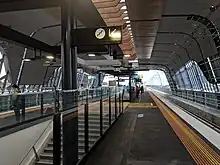
In compliance with the Disability Discrimination Act of 1992, all stations that are new-built or rebuilt are fully accessible and comply with these guidelines.[74] The majority of stations on the corridor are fully accessible, however, there are some stations that haven't been upgraded to meet these guidelines.[75] These stations do feature ramps, however, they have a gradient greater than 1 in 14.[75] Stations that are fully accessible feature ramps that have a gradient less than 1 in 14, have at-grade paths, or feature lifts.[75] These stations typically also feature tactile boarding indicators, independent boarding ramps, wheelchair accessible myki barriers, hearing loops, and widened paths.[75][76]
Projects improving station accessibility have included the Level Crossing Removal Project, which involves station rebuilds and upgrades, individual station upgrade projects, and associated Metro Tunnel works.[77][78] These works have made significant strides in improving network accessibility, with more than 66% of Cranbourne line stations classed as fully accessible. This number is expected to grow within the coming years, as a network restructure associated with the opening of the Metro Tunnel is completed by 2025.[79]
Signalling
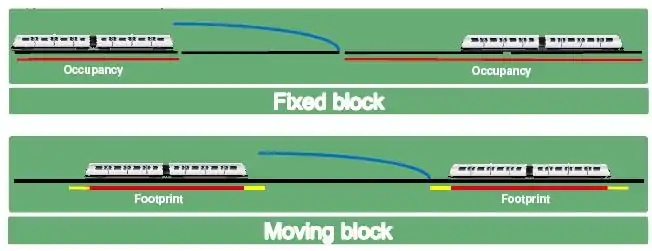
Since its re-opening in 1995, the Cranbourne line had used a fixed-block, three-position signalling system designed for lower frequencies and less services.[80] However, the ageing system had undermined reliability due to the presence of system faults and limited frequencies, requiring the Cranbourne, Pakenham, and Sunbury lines to upgrade their signalling system. Since 2021, high-capacity signalling (HCS) has been rolling out on the Pakenham, Cranbourne, and Sunbury lines, allowing trains to safely run closer together and run more frequently.[81] The new system is being delivered by CPB Contractors and Bombardier Transportation under the Rail Systems Alliance. These works valued at $1 billion includes the roll-out of 55 kilometres (34 mi) of HCS and communications systems on the aforementioned lines, allowing an increase in reliability and frequency.[82] The line will be equipped with Bombardier's CityFlo 650 communications-based train control system, which will enable operation at 2–3 minute headways.
The upgrade works were completed in phases from 2021. With the upgraded signalling system, trains are now able to run closer to each other. The new system was tested on the Mernda line and a section of the Cranbourne line before being fully implemented.[83] In March 2022, the Cranbourne line underwent further testing of high-tech signalling equipment, to ensure the new trains and signalling system can safely run alongside older-generation trains—including freight and V/Line trains—and the existing signalling system.[84]
References
- "Cranbourne Line". Public Transport Victoria. Retrieved 19 January 2023.
- "Metro's paper timetables mess". Daniel Bowen. 3 September 2017. Retrieved 9 December 2022.
- "High Capacity Metro Trains Project, Victoria, Australia". Railway Technology. Retrieved 9 December 2022.
- "The railway that brought an end to the pioneering days". Leongatha & District Heritage Society. 25 December 2022. Retrieved 25 December 2022.
- Millar, Royce (19 May 2006). "Election promise runs off the rails". The Age. Retrieved 28 December 2022.
- Lyndsay Neilson (2008). Butcher, John (ed.). Appendix 1: Funding Allocation, Victorian Area Strategies. doi:10.22459/AUC.04.2008. ISBN 9781921313776. Retrieved 1 November 2010.
{{cite book}}:|work=ignored (help) - "Advocacy | City of Casey". www.casey.vic.gov.au. Retrieved 15 January 2023.
- "Cranbourne Line Upgrade". Engage Victoria. Retrieved 31 December 2022.
- "Growing Our Rail Network 2018–2025". Public Transport Victoria. Retrieved 11 December 2022.
- Victoria's Big Build (28 November 2022). "About the Metro Tunnel Project". Victoria’s Big Build. Retrieved 9 December 2022.
- "What year did your railway station open? | Public Transport Users Association (Victoria, Australia)". 3 August 2018. Retrieved 9 December 2022.
- "Leongatha | Victorian Places". www.victorianplaces.com.au. Retrieved 25 December 2022.
- Victoria’s Big Build (13 February 2022). "Cranbourne Line duplicated, Greens Road crossing removed and new station open". Victoria’s Big Build. Retrieved 31 December 2022.
- "Great Southern Rail Trail". greatsouthernrt. Retrieved 25 December 2022.
- "Works". Newsrail. Vol. 20, no. 10. Vic: ARHS Victoria Division. October 1992. p. 330. ISSN 0310-7477. OCLC 19676396.
- Fiddian, Mark (1997). Trains, Tracks, Travelers. A history of the Victorian Railways. South Eastern Independent Newspapers. p. 154. ISBN 1-875475-12-5.
- "Farewell – The Sand Train". Newsrail. Vol. 26, no. 2. Vic: ARHS Victoria Division. February 1998. pp. 71–76. ISSN 0310-7477. OCLC 19676396.
- "Off the rails – South Gippsland Tourist Rail disbands". South Gippsland Sentinel Times. 19 January 2016. Retrieved 19 September 2016.
- "Media Release: CRANBOURNE STATION TRAIN STABLING PROJECT ON TRACK". Minister for Public Transport Media Release. dpc.vic.gov.au. Archived from the original on 22 July 2008. Retrieved 24 April 2008.
- Bichel, Lia (13 November 2008). "$37m train transformation". Cranbourne Star News. Retrieved 19 January 2023.
- "New 22 April timetable boosts Metro train trips by 353 a week – Premier of Victoria". 22 March 2012. Archived from the original on 22 March 2012. Retrieved 25 December 2022.
- Carey, Adam (22 April 2014). "Split-level luxury arrives at Springvale station, at $159 million". The Age. Retrieved 30 December 2022.
- "Springvale Level Crossing Removal - Mcconnell Dowell". www.mcconnelldowell.com. Retrieved 31 December 2022.
- "Qube Dandenong Cement (9571/9572)". Newsrail. Vol. 48, no. 1. Vic: ARHS Victoria Division. January 2020. p. 25. ISSN 0310-7477. OCLC 19676396.
- Jacks, Rob Harris, Timna (20 November 2020). "Melbourne Airport trains will run through the Metro tunnel every 10 minutes". The Age. Archived from the original on 5 May 2022. Retrieved 5 May 2022.
{{cite web}}: CS1 maint: multiple names: authors list (link) - Premier of Victoria (29 March 2021). "First look at long-awaited Melbourne Airport Rail". Archived from the original on 8 February 2023. Retrieved 5 May 2022.
- Victoria's Big Build (30 October 2022). "Melbourne Airport Rail overview". Victoria’s Big Build. Retrieved 11 December 2022.
- Victoria's Big Build (8 October 2022). "Melbourne Airport Rail timeline". Victoria’s Big Build. Retrieved 11 December 2022.
- LIZ BELL (27 October 2008). "Focus on public transport". Cranbourne Journal. cranbourne.yourguide.com.au. Archived from the original on 21 August 2011. Retrieved 4 November 2008.
- "NEW CRANBOURNE BUS SERVICES PUT THE TRAIN ON YOUR DOORSTEP". Media Release: OFFICE OF THE PREMIER. www.legislation.vic.gov.au. 7 November 2003. Archived from the original on 3 April 2011. Retrieved 4 November 2008.
- "Cranbourne East Extension". Victorian Transport Plan. www4.transport.vic.gov.au. Archived from the original on 11 July 2009. Retrieved 5 July 2012.
- Rees, Brendan (6 November 2018). "Slow train to Clyde". Cranbourne Star News. Retrieved 3 August 2023.
- PTV- Network Development Plan
- "Cranbourne Line Upgrade community update – September 2019". Victoria’s Big Build. 25 October 2022. Retrieved 26 December 2022.
- "Matthew Guy pledges $487m to extend Cranbourne train line to Clyde". www.9news.com.au. 11 July 2018. Retrieved 26 December 2022.
- "City of Casey welcomes Clyde Rail Link election commitment | City of Casey". www.casey.vic.gov.au. Retrieved 15 January 2023.
- Nsenduluka, Callum Godde and Mibenge (6 October 2022). "Vic premier vows full term if re-elected". The Canberra Times. Retrieved 15 January 2023.
- "2022 State election results". www.vec.vic.gov.au. Retrieved 15 January 2023.
- "Caulfield to Dandenong skyrail nears completion". Daniel Bowen. 18 March 2018. Retrieved 11 December 2022.
- "Caulfield to Dandenong (Skyrail) | Level Crossing Removal". Ecodynamics | Commercial Landscaping | Greening & Nurturing Our Communities. Retrieved 11 December 2022.
- "Pakenham Level Crossing Removals One Step Closer" (PDF). 27 July 2022.
- Cardinia Shire Council. "LXRP – Level Crossing Removal Project in Cardinia Shire". www.cardinia.vic.gov.au. Retrieved 11 December 2022.
- O'Keane, Tom (6 January 2022). "Contact awarded for $844M Melbourne rail works". Roads & Infrastructure Magazine. Retrieved 11 December 2022.
- Victoria’s Big Build (17 January 2023). "Cranbourne Line Upgrade". Victoria’s Big Build. Retrieved 19 January 2023.
- Williams, Gabrielle (19 March 2021). "First Step for Second Track as Cranbourne Works Gather Pace". State Member for Dandenong. Retrieved 31 December 2022.
- Chan, Ray (14 February 2022). "Cranbourne line works ahead of schedule". Rail Express. Retrieved 1 January 2023.
- Arnott, William (22 February 2022). "Cranbourne Line Duplication finished ahead of schedule". Inside Construction. Retrieved 25 December 2022.
- "More Melburnians could hop on a train or tram every 10 minutes under ambitious Greens proposal". ABC News. 22 August 2022. Retrieved 18 December 2022.
- "New timetable train line information – Public Transport Victoria". 1 March 2021. Archived from the original on 1 March 2021. Retrieved 18 December 2022.
- "280 extra Metro services coming in January". www.metrotrains.com.au. Retrieved 30 December 2022.
- "Melbourne Weekend Night Network Train Map" (PDF). 2022.
- "Timetable changes on the Cranbourne Line". Public Transport Victoria. Archived from the original on 9 February 2022. Retrieved 9 February 2022.
- "Where do train replacement buses come from?". ABC News. 15 November 2016. Retrieved 18 December 2022.
- "Cranbourne Line". Public Transport Victoria. Retrieved 26 December 2022.
- "Melbourne's Rail Network to be Split" Railway Digest November 1997 page 12
- National Express walks out of Australian rail service The Daily Telegraph (London) 17 December 2002
- Receivers take over train, tram group The Age 24 December 2002
- Victorian passenger services get new managers Rail Express 28 January 2003
- Cooper, Mex (25 June 2009). "New train, tram operators for Melbourne". The Age. Archived from the original on 1 January 2023. Retrieved 1 January 2023.
- Carey, Adam (4 June 2015). "Multimillion-dollar Richmond railway station revamp in limbo". The Age. Retrieved 12 December 2022.
- "Guide to navigating the City Loop | Public Transport Users Association (Victoria, Australia)". Retrieved 12 December 2022.
- Wong, Marcus (10 May 2021). "Level crossing removals in 1920s Melbourne". Waking up in Geelong. Retrieved 12 December 2022.
- "Sky train project for Melbourne's busiest rail line gets go-ahead". ABC News. 6 February 2016. Retrieved 12 December 2022.
- "Network Maps". www.metrotrains.com.au. Retrieved 27 December 2022.
- "Quicker Commutes, Better Connectivity – Liberals And Nationals To Extend Railway Line Through Melbourne's Growing South-east". vic.liberal.org.au. Retrieved 26 December 2022.
- Lee, Robert S. (2007). The railways of Victoria 1854–2004. Rosemary Annable, Donald S. Garden. Carlton, Vic.: Melbourne University Publishing. ISBN 978-0-522-85134-2. OCLC 224727085.
- "Caulfield to Dandenong Railway & Linear Park". ASPECT Studios. Retrieved 29 December 2022.
- Anderson, Rick (2010). Stopping All Stations. Clunes, Victoria: Full Parallel Productions. ISBN 978-0646543635. OCLC 671303814.
- Planning, Department of Transport and. "Bigger trains for a better Melbourne". dtp.vic.gov.au. Retrieved 10 March 2023.
- Galloway, Anthony (24 August 2016). "Alarm over Chinese trains".
- "Comeng trains starting to be scrapped". Daniel Bowen. 17 October 2021. Retrieved 12 December 2022.
- Victorian Government Department of Transport and Planning (2023). "New train and tram orders".
- "NETWORK SERVICE PLAN | Addenda". 1 February 2011. Archived from the original on 7 March 2011.
- "Accessibility – Public Transport Ombudsman Victoria". www.ptovic.com.au. Retrieved 3 January 2023.
- "Station accessibility features". Metro Trains Melbourne. 2023.
- "Accessing public transport". City of Melbourne. n.d.
- "Left behind: the fight for accessible public transport in Victoria". the Guardian. 12 June 2022. Retrieved 3 January 2023.
- Victoria’s Big Build (17 October 2022). "Urban design framework". Victoria’s Big Build. Retrieved 3 January 2023.
- "Growing Our Rail Network 2018–2025". Public Transport Victoria. Retrieved 3 January 2023.
- Fisher, Peter (2007). Victorian Signalling: by Accident or Design?. Australian Railway Historical Society (Victorian Division). ISBN 978-1-920892-50-0
- Victoria's Big Build (18 March 2022). "High Capacity Signalling". Victoria’s Big Build. Retrieved 13 December 2022.
- "Victoria awards Melbourne Metro high-capacity signalling contract". Railway PRO. 19 July 2017. Retrieved 13 December 2022.
- Victoria's Big Build (18 March 2022). "Testing on the Mernda line". Victoria’s Big Build. Retrieved 13 December 2022.
- Mirage News (24 December 2021). "Upgrades to bring more trains more often". Mirage News. Retrieved 13 December 2022.
External links
- Cranbourne line timetable
- Network map
 Media related to Cranbourne railway line at Wikimedia Commons
Media related to Cranbourne railway line at Wikimedia Commons